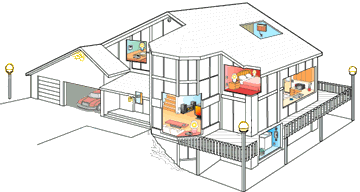ResidentialTechnology.com

Several industries are interested in residential connectivity markets, a highly-simplified breakdown of them includes:
- Energy/Utilities/Powerline Networking Manufacturers
- Telecommunication Service Providers/The Telephone Company/Telephony Line Networking Manufacturers
- The Cable Service, Modem, Set-Top Box, Fiber Optic Cable Manufacturers & Satellite Companies
- Wireless and Infrared Networking Manufacturers
- Entertainment Online, Television Broadcasting and Digital Content Providers
- PC, Consumer Electronics, Audio/Visual and Software
- Home and Multiple Dwelling Unit (MDU) Builders, Custom Installers, Retailers
- Silicon/Microchip Manufacturers
- Financial Analysts/Research Groups/Venture Capitalists/IPO Underwriters
ABOUT THE AUTHOR, "Papa" Lorenzo:

BIG on samples and happy hour buffets, periodically declares he's giving up on cheese (might as well call him "anti-American" i know), LOVES his wife (remember, "wife" spelled backwards is "efiw"), is certain his son is destined to be known as "Enzo the Great," appreciates his "parents" more each day (in-laws included), still dislikes cats, greatest fear is mediocrity, has resigned himself to blatant self-promotion (hey! i amuse me), defies popularity by defining himself, and wants (would like) you to pay him lots (market-value) of money for his work.

RESIDENTIAL TECHNOLOGY A Monthly Column with Lorenzo D. Domínguez Residential Connectivity and Convergence:
The Office Comes Home or How Home Networking Stocks
Will Make You Richer in the Year 2000
TELECOMMUNICATION SERVICE PROVIDERS/THE TELEPHONE COMPANY/TELEPHONY LINE NETWORKING MANUFACTURERS:
Without going into the entire history of telephony decentralization (i.e. the break up of Ma Bell/AT&T into RBOCs in 1984 and the subsequent TA96), the major telephone companies dread the competition which is on the horizon in the form of Competing Local Access Competitors (CLECs), Internet Service Providers (ISPs) and Intralata Exchange Carriers (IXCs which are also now becoming CLECs), because with the increased demand in data services (i.e. connecting to the Internet) and the emergence of superior, miniaturized and all-encompassing networking and computing technologies and consumer offerings the giant RBOCs are finding it hard to keep up with the hundreds of little guy start-ups which are beating them at their own game.
Moreover, networking over the phoneline and broadband access technologies have drastically improved in the last couple of years and phone and ISP companies alike would like to sell them. The biggest concern here is how do you do just that? How do you educate the consumer about the need for speed? At the same time, most companies in this area, both new and old, are attempting to beat the competition with all-in-one One-Stop shopping services, so that consumers can purchase their entertainment, wired telephony, wireless, Internet access, pager and cable TV services from one company.
The biggest battle being waged is over the race to be the sole provider of high-speed bandwidth to the residential consumer, basically only exit off the information superhighway into your home.
Major Supporting Technology Standard Working Group/Industry Alliance Association:
- Copper Development Association http://www.copper.org/
- Home Phoneline Networking Alliance ( HomePNA)
- The Asynchronous Digital Subsriber Line Forum (ADSL Forum)
The Home Phoneline Networking Alliance has developed an Ethernet-like specification for existing telephone wiring based on technology from Tut Systems. HomePNA PC-networking products are available now. Established June 1998. Open Service Gateway Initiative (OSGi) A group of 13 computer, phone and electric utility companies are promoting this Java-based standard, the Open Service Gateway, to provide a two-way link between service providers and households.
ADSL Asymmetric Digital Subscriber Line. A method for moving data over regular phone lines. An ADSL circuit is much faster than a regular phone connection, and the wires coming into the subscriber's premises are the same (copper) wires used for regular phone service. DSL Digital Subscriber Line. A family of related "broadband over phone wire" technologies
The Service Companies
- AT&T
- US West
- GTE
- Bell Canada
- Bell Atlantic
- Sprint
- Covad Communications
- Convergent Network
The Vendor Companies
- 2Wire (Private)
- Broadcom
Tut Systems
